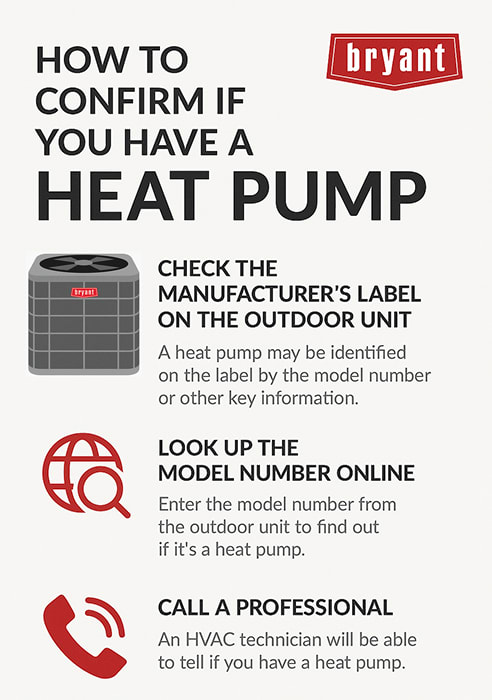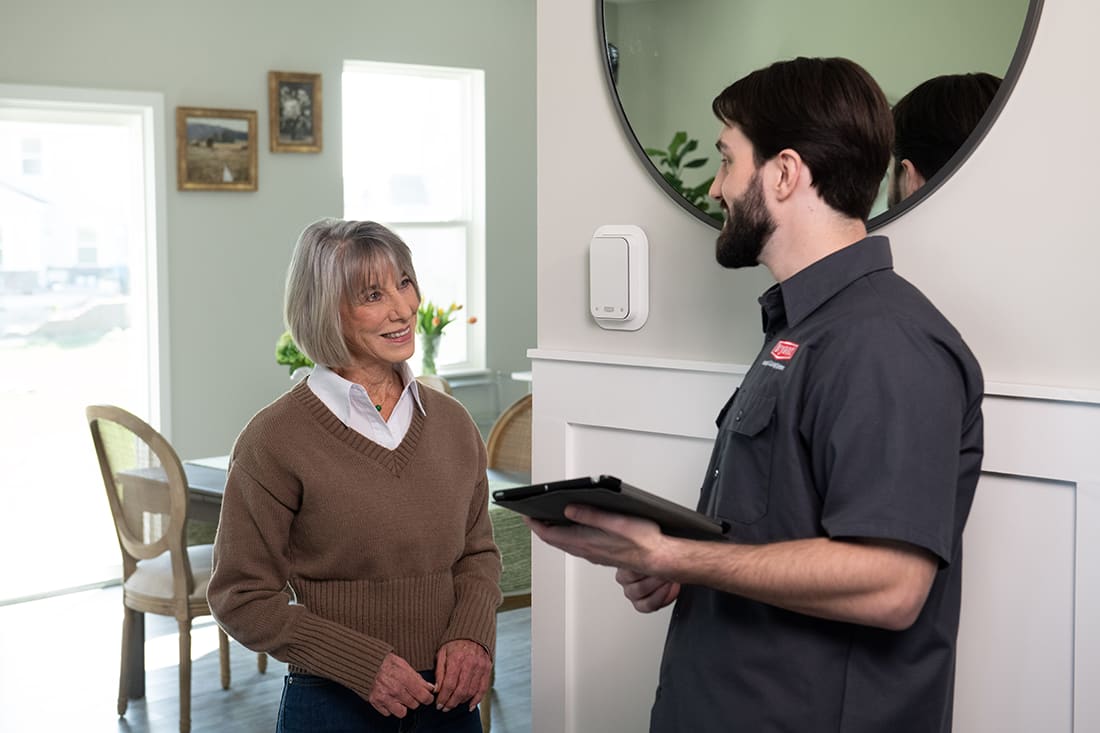About The Author: Travis Baugh is a Digital Brand Marketing Manager for Bryant, where he creates clear, helpful content to guide homeowners through heating, cooling, and indoor air quality decisions. His goal is to empower readers with the knowledge they need to choose the right comfort solutions for their home—confidently and comfortably.
How Do I Know if I Have a Heat Pump?
If you're wondering whether your home heating and cooling system is a heat pump or a traditional air conditioner, you're not alone. Many homeowners aren’t sure which type of system they have, especially since heat pumps and central air conditioners can look nearly identical from the outside. However, knowing whether you have a heat pump is important because it determines how your home is heated and cooled—and it can affect how you maintain your system, what kind of thermostat you need, and how energy-efficient your home is.
Here’s a comprehensive guide to help you figure out whether your HVAC system is a heat pump, and what to look for if you’re unsure.
Understanding Heat Pumps vs. Conventional Systems
How to know if you have a heat pump? A heat pump is a type of HVAC system that provides both heating and cooling by transferring heat rather than generating it. In the summer, it works like a standard air conditioner—pulling heat from inside your home and moving it outside. In the winter, it reverses this process, pulling heat from the outside air and bringing it indoors. Learn more about how heat pumps work. Traditional furnaces generate heat by burning fuel or using electric coils but don’t provide cooling, while air conditioners cool the air but don't provide heating. Learn more about a heat pump vs furnace.
Heat pumps combine both functions into one system, offering year-round comfort without needing separate units for heating and cooling. They are generally more energy-efficient than traditional split systems of a furnace and air conditioner, which can result in lower heating and cooling bills and a reduced carbon footprint, contributing to a sustainable home environment. Modern heat pumps often include smart technology for optimal temperature control and energy savings. Understanding these characteristics is a significant first step in identifying how to tell if you have a heat pump in your home.
Why Does It Matter?
Knowing if you have a heat pump system can help you:
- Understand your heating and cooling bills
- Schedule the right type of HVAC service
- Program your thermostat properly
- Take advantage of potential rebates or federal tax credits
- Decide if a dual fuel system might be beneficial
Signs You Might Have a Heat Pump
- You Feel Warm Air from Vents While the Outdoor Unit Is Running in Winter. This is one of the biggest clues. If you hear your outdoor unit running while your system is heating your home (especially in mild winter temperatures), you likely have a heat pump. Traditional furnaces do not use the outdoor condenser in heating mode.
- Your Thermostat Has “Emergency Heat” or “Aux Heat”. Heat pump thermostats typically include an “Emergency Heat” or “Aux Heat” setting. This auxiliary heat kicks in when it’s too cold outside for the heat pump to efficiently extract heat from the air. If you see these options on your thermostat, you likely have a heat pump system.
How to Confirm If You Have a Heat Pump

If the clues above aren’t conclusive, here are a few simple ways to check for sure:
- Check the Manufacturer’s Label on the Outdoor Unit. Look for a label or data plate on your outdoor unit. You may see model information that includes terms like “HP” (for heat pump) or “Heat Pump”. If you're unsure how to read the model number, you can search it online along with the manufacturer name.
- Look Up the Model Number Online. The easiest and most accurate way is to search the full model number of your outdoor unit online. The manufacturer’s website or product description should clearly state whether it’s a heat pump.
- Call a Professional. If you still aren’t sure, your local Bryant dealer can inspect your system and tell you exactly what kind of setup you have. A professional can also walk you through how it works and what maintenance it needs.
What If You Have a Heat Pump?
If you’ve confirmed you have a heat pump, congratulations! You have a versatile, energy-efficient system. Here’s what you should keep in mind:
- Year-Round Maintenance: Heat pumps run year-round, so they typically need more frequent maintenance than systems used seasonally. Professional heat pump maintenance in both spring and fall is recommended.
- Thermostat Settings: Heat pumps work best with programmable thermostats designed for heat pump systems. Avoid frequent temperature swings, which can trigger backup heat and reduce efficiency.
- Cold Weather Performance: In very cold climates, your heat pump may rely more on auxiliary heat. Some homeowners opt for a dual fuel heat pump system that pairs a heat pump with a gas furnace for improved efficiency. Cold climate heat pumps are built to withstand cold weather without the need for an auxiliary heat source.

What If You Don’t Have a Heat Pump?
If your system turns out to be a traditional air conditioner with a furnace, you’re still in good shape—but there are benefits to considering a heat pump in the future. Heat pumps are especially efficient in moderate to mild climates and are becoming more common in colder regions thanks to advancements in cold-climate technology.
If you're considering replacing your HVAC system, speak with a Bryant dealer to explore whether a heat pump or a dual fuel system might offer better performance and efficiency for your home.
More Questions On Heat Pumps? Contact A Bryant Dealer
Figuring out whether you have a heat pump doesn’t have to be complicated. Look for signs like year-round operation, outdoor unit activity in the winter, and “Aux Heat” settings on your thermostat. You can also confirm by checking the unit's model number or calling your local Bryant dealer.
Knowing your system type helps you make better decisions for maintenance, energy use, and future upgrades. If you discover you don’t have a heat pump but are interested in switching to one, your local Bryant dealer can walk you through heat pump replacement options tailored to your home and climate.
Learn More About Heat Pumps
- Explore the value of high efficiency heat pumps
- Find out more about heat pump installation
- Explore heat pump repair
- Read our guide to heat pump cost
- Understand what is an electric heat pump
- Learn what is an air source heat pump


